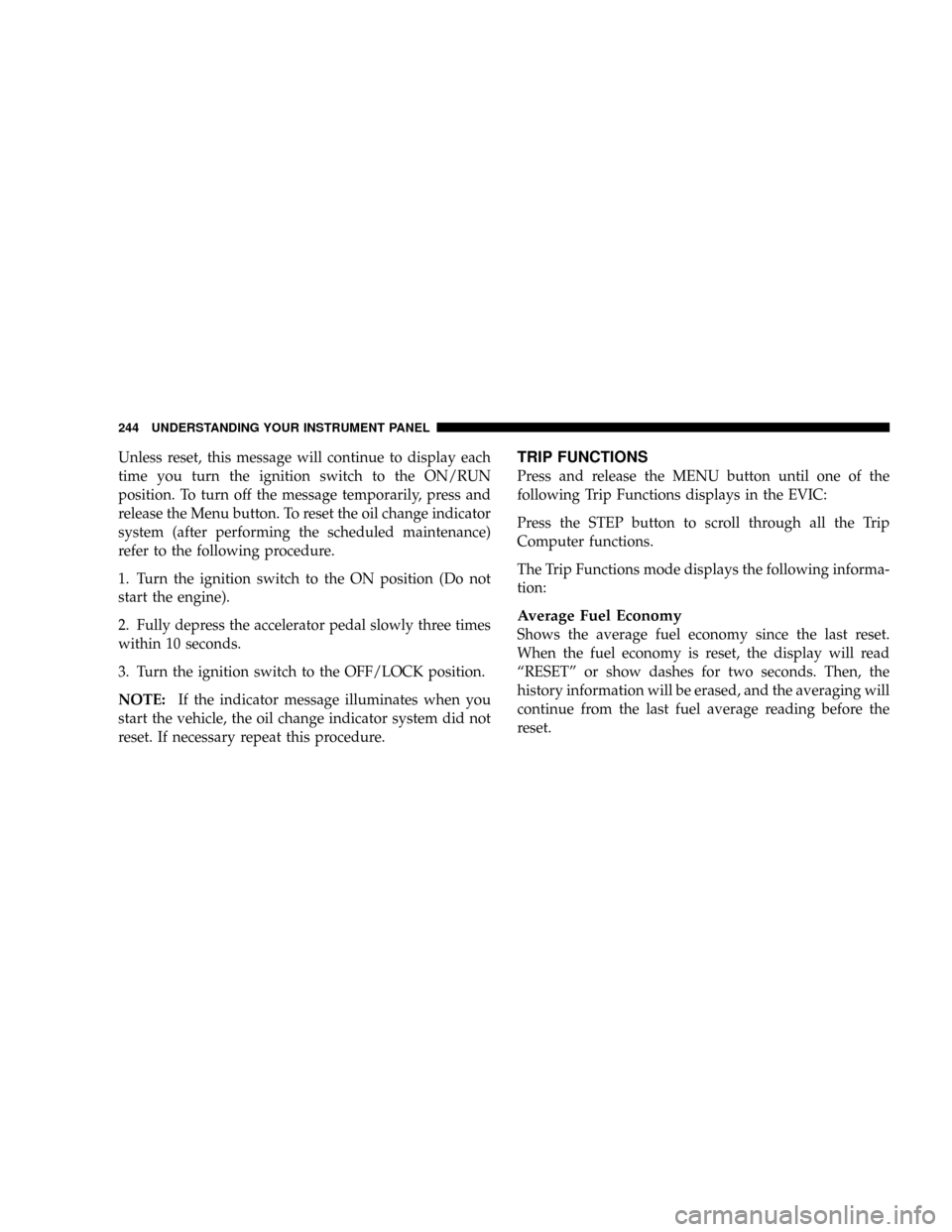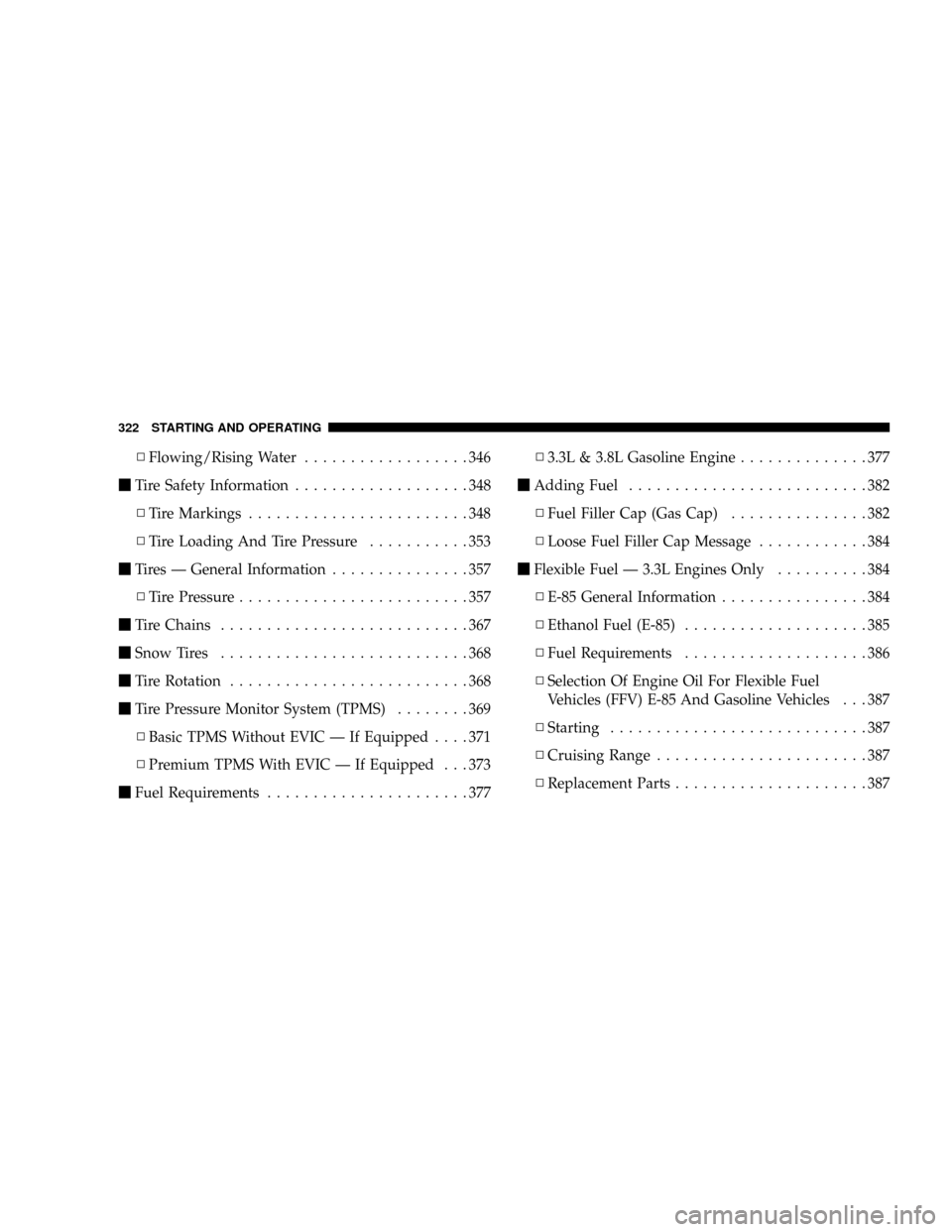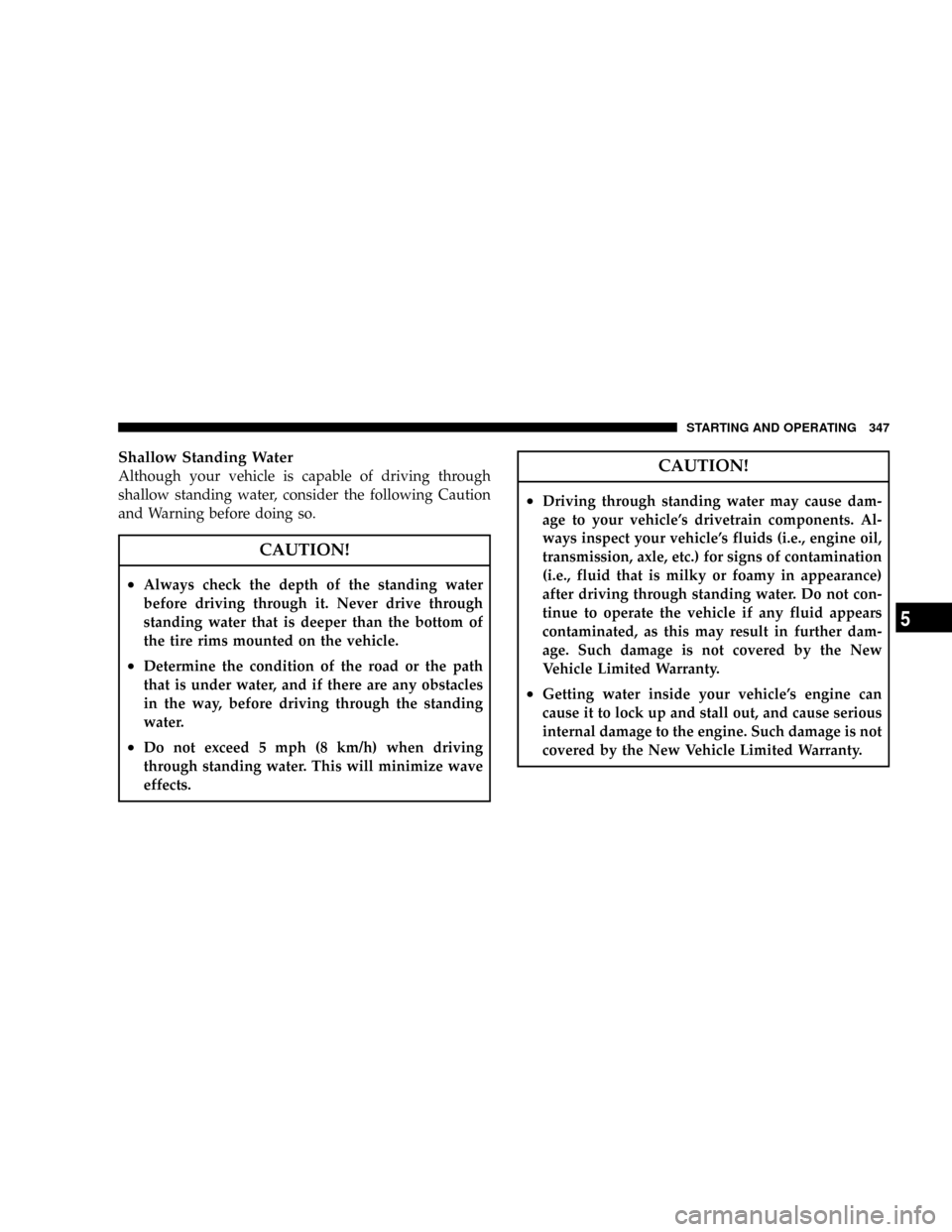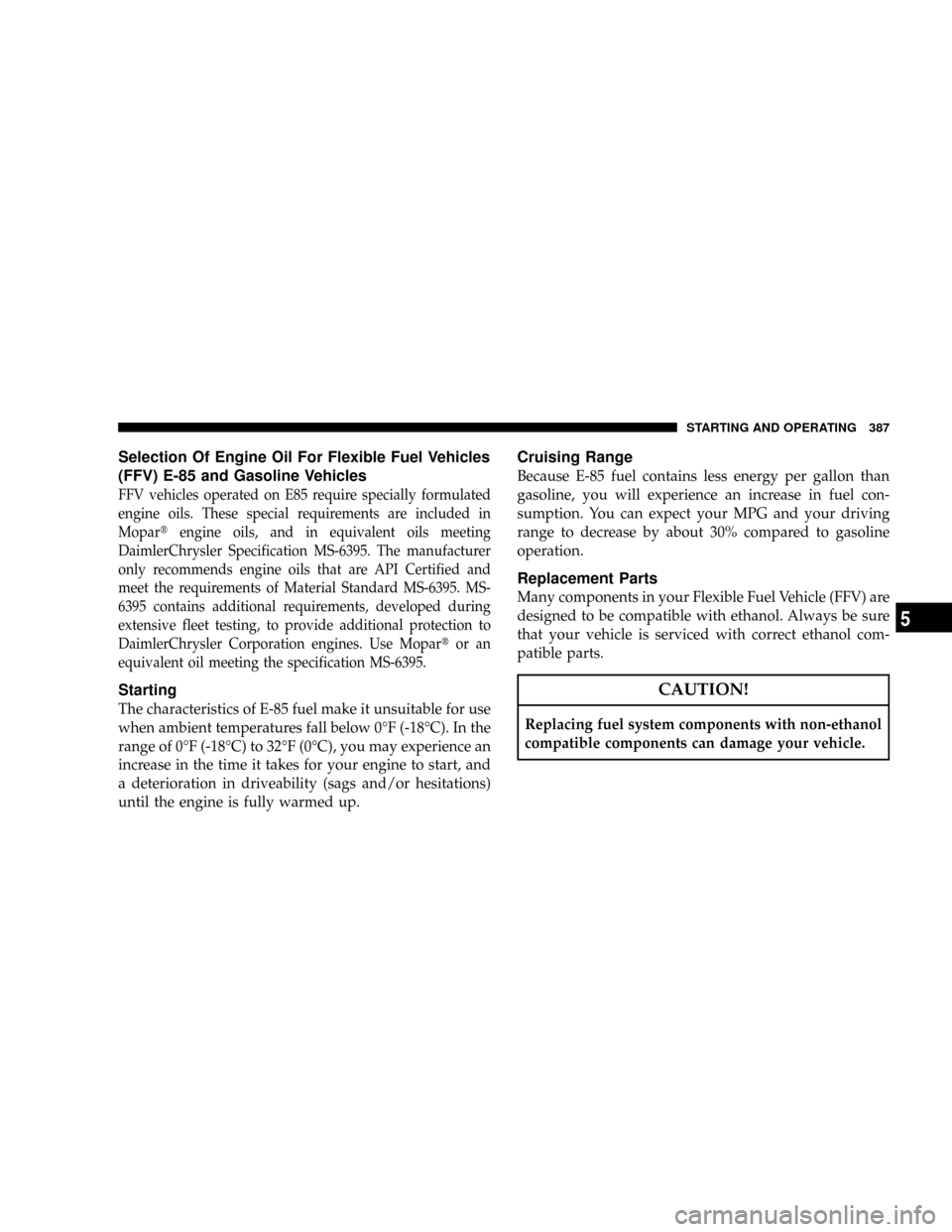Page 246 of 531

Unless reset, this message will continue to display each
time you turn the ignition switch to the ON/RUN
position. To turn off the message temporarily, press and
release the Menu button. To reset the oil change indicator
system (after performing the scheduled maintenance)
refer to the following procedure.
1. Turn the ignition switch to the ON position (Do not
start the engine).
2. Fully depress the accelerator pedal slowly three times
within 10 seconds.
3. Turn the ignition switch to the OFF/LOCK position.
NOTE:If the indicator message illuminates when you
start the vehicle, the oil change indicator system did not
reset. If necessary repeat this procedure.TRIP FUNCTIONS
Press and release the MENU button until one of the
following Trip Functions displays in the EVIC:
Press the STEP button to scroll through all the Trip
Computer functions.
The Trip Functions mode displays the following informa-
tion:
Average Fuel Economy
Shows the average fuel economy since the last reset.
When the fuel economy is reset, the display will read
ªRESETº or show dashes for two seconds. Then, the
history information will be erased, and the averaging will
continue from the last fuel average reading before the
reset.
244 UNDERSTANDING YOUR INSTRUMENT PANEL
Page 324 of 531

NFlowing/Rising Water..................346
mTire Safety Information...................348
NTire Markings........................348
NTire Loading And Tire Pressure...........353
mTires Ð General Information...............357
NTire Pressure.........................357
mTire Chains...........................367
mSnow Tires...........................368
mTire Rotation..........................368
mTire Pressure Monitor System (TPMS)........369
NBasic TPMS Without EVIC Ð If Equipped....371
NPremium TPMS With EVIC Ð If Equipped . . . 373
mFuel Requirements......................377N3.3L & 3.8L Gasoline Engine..............377
mAdding Fuel..........................382
NFuel Filler Cap (Gas Cap)...............382
NLoose Fuel Filler Cap Message............384
mFlexible Fuel Ð 3.3L Engines Only..........384
NE-85 General Information................384
NEthanol Fuel (E-85)....................385
NFuel Requirements....................386
NSelection Of Engine Oil For Flexible Fuel
Vehicles (FFV) E-85 And Gasoline Vehicles . . . 387
NStarting............................387
NCruising Range.......................387
NReplacement Parts.....................387
322 STARTING AND OPERATING
Page 349 of 531

Shallow Standing Water
Although your vehicle is capable of driving through
shallow standing water, consider the following Caution
and Warning before doing so.
CAUTION!
²Always check the depth of the standing water
before driving through it. Never drive through
standing water that is deeper than the bottom of
the tire rims mounted on the vehicle.
²Determine the condition of the road or the path
that is under water, and if there are any obstacles
in the way, before driving through the standing
water.
²Do not exceed 5 mph (8 km/h) when driving
through standing water. This will minimize wave
effects.
CAUTION!
²Driving through standing water may cause dam-
age to your vehicle's drivetrain components. Al-
ways inspect your vehicle's fluids (i.e., engine oil,
transmission, axle, etc.) for signs of contamination
(i.e., fluid that is milky or foamy in appearance)
after driving through standing water. Do not con-
tinue to operate the vehicle if any fluid appears
contaminated, as this may result in further dam-
age. Such damage is not covered by the New
Vehicle Limited Warranty.
²Getting water inside your vehicle's engine can
cause it to lock up and stall out, and cause serious
internal damage to the engine. Such damage is not
covered by the New Vehicle Limited Warranty.
STARTING AND OPERATING 347
5
Page 389 of 531

Selection Of Engine Oil For Flexible Fuel Vehicles
(FFV) E-85 and Gasoline Vehicles
FFV vehicles operated on E85 require specially formulated
engine oils. These special requirements are included in
Mopartengine oils, and in equivalent oils meeting
DaimlerChrysler Specification MS-6395. The manufacturer
only recommends engine oils that are API Certified and
meet the requirements of Material Standard MS-6395. MS-
6395 contains additional requirements, developed during
extensive fleet testing, to provide additional protection to
DaimlerChrysler Corporation engines. Use Mopartor an
equivalent oil meeting the specification MS-6395.
Starting
The characteristics of E-85 fuel make it unsuitable for use
when ambient temperatures fall below 0ÉF (-18ÉC). In the
range of 0ÉF (-18ÉC) to 32ÉF (0ÉC), you may experience an
increase in the time it takes for your engine to start, and
a deterioration in driveability (sags and/or hesitations)
until the engine is fully warmed up.
Cruising Range
Because E-85 fuel contains less energy per gallon than
gasoline, you will experience an increase in fuel con-
sumption. You can expect your MPG and your driving
range to decrease by about 30% compared to gasoline
operation.
Replacement Parts
Many components in your Flexible Fuel Vehicle (FFV) are
designed to be compatible with ethanol. Always be sure
that your vehicle is serviced with correct ethanol com-
patible parts.
CAUTION!
Replacing fuel system components with non-ethanol
compatible components can damage your vehicle.
STARTING AND OPERATING 387
5
Page 413 of 531
the fan control to High. This allows the heater core to act
as a supplement to the radiator and aids in removing heat
from the engine cooling system.
CAUTION!
Driving with a hot cooling system could damage
your vehicle. If temperature gauge reads ªHº, pull
over and stop the vehicle. Idle the vehicle with the air
conditioner turned off until the pointer drops back
into the normal range. If the pointer remains on the
ªHº, turn the engine off immediately, and call for
service.
WARNING!
A hot engine cooling system is dangerous. You or
others could be badly burned by steam or boiling
coolant. You may want to call a service center if your
vehicle overheats. If you decide to look under the
hood yourself, see Section 7, Maintenance, of this
manual. Follow the warnings under the Cooling
System Pressure Cap paragraph.
WHAT TO DO IN EMERGENCIES 411
6
Page 433 of 531
MAINTAINING YOUR VEHICLE
CONTENTS
m3.3L Engine Compartment................434
m3.8L Engine Compartment................435
m4.0L Engine Compartment................436
mOnboard Diagnostic System Ð OBD II........437
NLoose Fuel Filler Cap Message Ð gASCAP . . . 438
mEmissions Inspection And Maintenance
Programs............................438
mReplacement Parts......................440
mAuthorized Dealer Service................440mMaintenance Procedures..................441
NEngine Oil..........................441
NEngine Oil Filter......................444
NDrive Belt...........................445
NSpark Plugs.........................445
NEngine Air Cleaner....................445
NCatalytic Converter....................446
NMaintenance-Free Battery................448
NAir Conditioner Maintenance.............450
7
Page 443 of 531
MAINTENANCE PROCEDURES
The pages that follow contain therequiredmaintenance
services determined by the engineers who designed your
vehicle.
Besides the maintenance items for which there are fixed
maintenance intervals, there are other items that should
operate satisfactorily without periodic maintenance.
However, if a malfunction of these items does occur, it
could adversely affect the engine or vehicle performance.
These items should be inspected if a malfunction is
observed or suspected.
ENGINE OIL
Checking Oil Level
To assure proper engine lubrication, the engine oil must
be maintained at the correct level. Check the oil level at
regular intervals, such as every fuel stop.
The best time to check the engine oil level is about five
minutes after a fully warmed engine is shut off or before
starting the engine after it has sat overnight.
MAINTAINING YOUR VEHICLE 441
7
Page 444 of 531
Checking the oil while the vehicle is on level ground will
improve the accuracy of the oil level readings. Maintain
the oil level between the MIN and MAX markings on the
dipstick. Adding one quart of oil when the reading is at
the MIN mark will result in a MAX reading on these
engines.CAUTION!
Overfilling or underfilling will cause oil aeration or
loss of oil pressure. This could damage your engine.
Change Engine Oil
The oil change indicator system will remind you that it is
time to take your vehicle in for scheduled maintenance.
Refer to ªMaintenance Scheduleº in Section 8 of this
manual for information on this system.
NOTE: Under no circumstances should oil change
intervals exceed 6,000 miles (10 000 km) or six months,
whichever occurs first.
Engine Oil Selection
For best performance and maximum protection under all
types of operating conditions, the manufacturer only
Engine Oil Dipstick
442 MAINTAINING YOUR VEHICLE